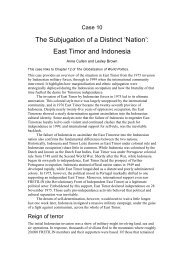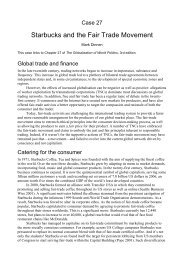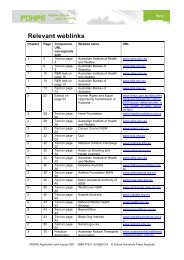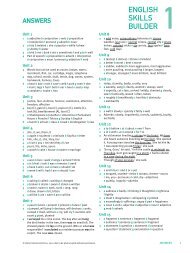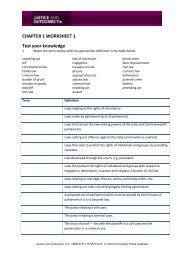2 Chapter 6 ⢠organising elements Organising elements
2 Chapter 6 ⢠organising elements Organising elements
2 Chapter 6 ⢠organising elements Organising elements
You also want an ePaper? Increase the reach of your titles
YUMPU automatically turns print PDFs into web optimized ePapers that Google loves.
6<br />
Some properties of Dobereiner’s triads are listed in Table 6.1.<br />
Table 6.1<br />
Element<br />
Properties of the <strong>elements</strong> in Dobereiner’s triads<br />
Atomic<br />
mass<br />
Melting point<br />
(°C)<br />
<strong>Chapter</strong> 6 • <strong>organising</strong> <strong>elements</strong><br />
Density<br />
(g/mL)<br />
Melting point of<br />
chloride (°C)<br />
Lithium 7 180 0.53 LiCl = 610<br />
Sodium 23 98 0.97 NaCl = 801<br />
Potassium 39 64 0.86 KCl = 770<br />
Element<br />
Atomic<br />
mass<br />
Melting point<br />
(°C)<br />
Density<br />
(g/mL)<br />
Melting point of<br />
sodium salt (°C)<br />
Chlorine 35.5 –101 1.56 NaCl = 801<br />
Bromine 80 –7 3.12 NaBr = 747<br />
Iodine 127 114 4.94 NaI = 660<br />
Element<br />
Atomic<br />
mass<br />
Melting point<br />
(°C)<br />
Density<br />
(g/mL)<br />
Melting point of<br />
chloride (°C)<br />
Calcium 40 838 1.55 CaCl 2<br />
= 772<br />
Strontium 88 770 2.60 SrCl 2<br />
= 872<br />
Barium 137 714 3.50 BaCl 2<br />
= 963<br />
Element<br />
Atomic<br />
mass<br />
Melting point<br />
(°C)<br />
Density<br />
(g/mL)<br />
Melting point of<br />
sodium salt (°C)<br />
Sulfur 32 113/119 2.07/1.96 Na 2<br />
S = 1180<br />
Selenium 79 217 4.80 Na 2<br />
Se = >875<br />
Tellurium 128 450 6.24 Na 2<br />
Te = 953<br />
1864<br />
English chemist John<br />
Newlands took a slightly<br />
different approach.<br />
Building on the atomic<br />
weights of the <strong>elements</strong>,<br />
he noticed that every<br />
eighth element had similar<br />
properties. Many of these<br />
‘eighth’ <strong>elements</strong> were part of<br />
Dobereiner’s triads. This pattern<br />
identification by Newlands was<br />
considered a recurring or ‘periodic’<br />
feature among the <strong>elements</strong>. Newlands<br />
made the mistake of comparing the<br />
properties of the <strong>elements</strong> to music,<br />
with musical notes being grouped<br />
eight per octave. This comparison,<br />
called the Law of Octaves, was not<br />
taken seriously by Newlands’ peers.<br />
The birth of the<br />
periodic table<br />
1869<br />
Dmitri Mendeleev is hailed as the creator of<br />
the modern periodic table. Building on the<br />
ideas of his contemporaries, Mendeleev, who<br />
lived in Russia, knew of 63 <strong>elements</strong>.<br />
Fig 6.4 A sculpture in honour of Dmitri Mendeleev<br />
and the periodic table in Saint Petersburg.<br />
What do you know about getting<br />
<strong>elements</strong> organised?<br />
1 Who proposed the modern idea of an element and when?<br />
2 The chemist Jakob Berzelius did not discover anything. Why is he<br />
remembered?<br />
3 What was a triad? Why were triads important?<br />
4 Why were the ideas of Newlands’ not taken seriously? Is this a fair<br />
assessment of his ideas?<br />
5 Originally, geometric symbols were used to represent each element.<br />
What would be some of the problems associated with using geometric<br />
symbols for the <strong>elements</strong> today?<br />
UNCORRECTED PAGE PROOFS<br />
CAS_SB10_TXT_06_1pp.indd 6<br />
11/11/11 4:58 PM






